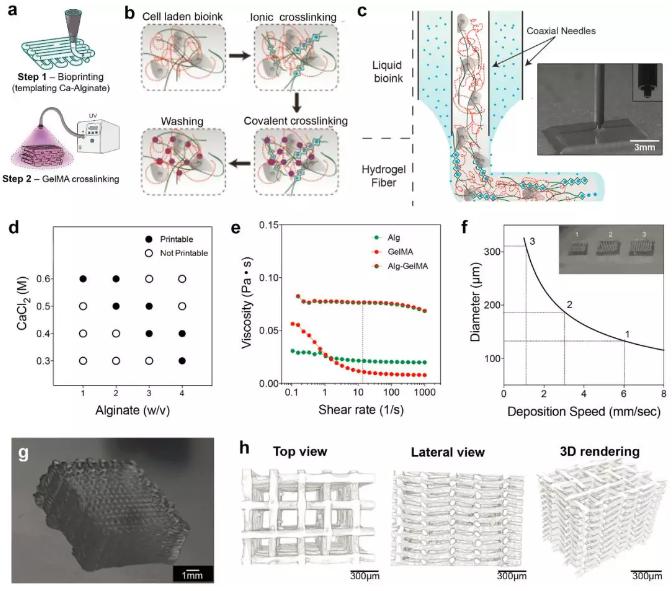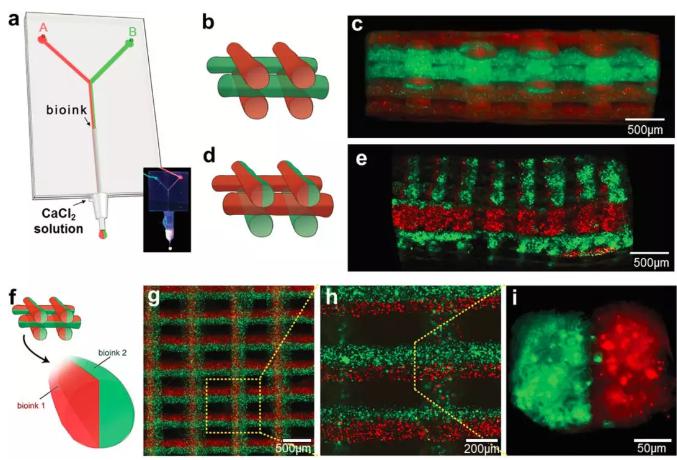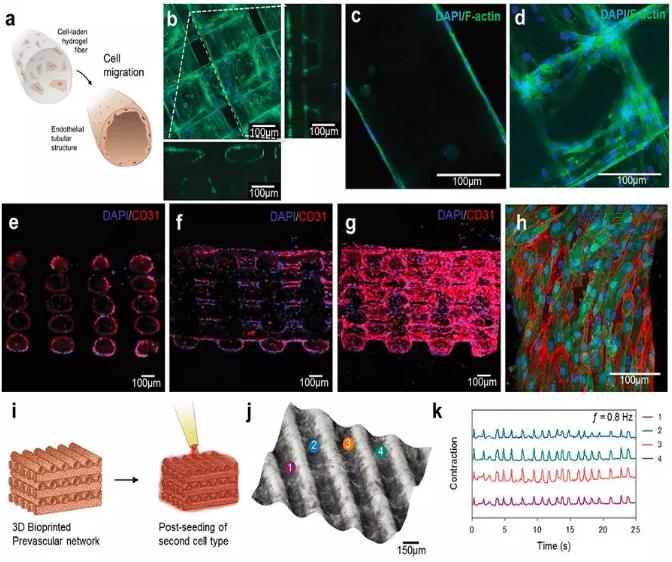微流控生物打印異質3D組織結構
具有特定生物和機械性能的3D功能性組織結構在再生醫學和組織工程領域相當重要。但是,高度組織化、功能性的3D組織的發展仍面臨一個未解決的挑戰。在體外重現包含多種細胞和細胞外基質(ECM)的3D多級結構是一個相當不容易的任務。在這樣的背景下,生物打印作為一種有潛力制備仿生3D組織結構的新技術已經出現。生物打印可以根據需要實現多細胞結構的精確定位。以往研究者們已經將這種技術應用于生物需要,例如打印軟骨或多細胞結構,且在打印分辨率和細胞需求方面都取得了不錯的結果。盡管在3D生物打印方面有著不錯的進展,但對不同細胞的精確定位和轉換以及尋求合適的生物材料仍是主要的挑戰之一。
基于此,哈佛醫學院的Ali Khademhosseini教授和羅馬大學的Mariella Dentini教授合作團隊提出了一種新的生物打印范例,他們將3D生物打印和微流控芯片相結合,將打印分辨率和打印效率提升到一個新的水平,同時該方法還具有以下優勢:
1)能夠同時打印多種材料;
2)可制備具有活性的載細胞3D結構;
3)使用可以誘導細胞擴散和遷移的生物墨水;
4)能夠在生物打印的支架上播種另一種細胞。首先,該團隊選擇使用海藻酸鹽和GelMA混合的低粘度生物墨水進行生物打印,選用GelMA是因為其可促進細胞粘附和細胞遷移。低粘度的GelMA對細胞的封裝效果更接近于天然基質,但低粘度GelMA很難作為生物墨水進行打印,在固化前易出現擴散現象。而海藻酸鹽作為混合組分之一,可通過離子交聯起到固定結構的作用。該生物打印技術的示意圖如(圖1 a-c)所示,先通過物理交聯得到打印模板,再通過UV共價交聯得到穩定的3D組織結構(圖1 g-h)。

Figure 1. a) Schematic illustration of thelayer-by-layer-deposition-based bioprinting technique consisting of two independent crosslinking steps. b,c) The bioink contained GelMA (red dashed lines), alginate (green lines), photoinitiator, and cells in the inner needle of thecoaxial system. Simultaneously theCaCl2(blue dots) solution flows through the outer needle to induce the gelation of alginate chains. The construct wasthen UV crosslinked to solidify the GelMA prepolymer in the fi ber. d)Printability of different alginate concentrations and different CaCl2 concentrations. GelMA concentration was kept constant (4.5% w/v). e) Viscosities of alginateand GelMA, and the combination of both at room temperature. f) The fiber diameter varied with different deposition speeds, calculated for a bioink flow rate of 5 μL min?1 . In theupper-right corner, photographs of the 1 mm thick constructs obtained for deposition speeds of 6 mm s?1 , 3 mm s?1 , and 1 mm s?1. g) Photograph of the final construct (30 layers). h) Top, lateral and 3D μCT reconstructions of the final bioprinted 3D structure.
為了證明制備多組分或多細胞組織結構的可行性,研究人員將一個微流控體系與生物打印相結合,可快速制備不同材料構成的仿生組織結構(圖2 a)。將“Y”型通道的微流控芯片與同軸針頭鏈接,分別注入不同墨水,用紅色和綠色熒光顆粒標記。通過選擇不同的墨水打印,研究者們可實現連續打印不同材料,得到包含不同墨水在不同層上的異質結構(圖2 b-e)。或者,當兩種墨水同時擠出將得到多相纖維組成的3D結構(圖2 d,f-i)。

Figure 2. a) A microfluidic system was used to flow two separate bioinks containing red and green fluorescent beads that exited the device through a single extruder. Photograph (inset) of the coaxial needle system with a microfluidic chip with a “Y”-shaped channel. The schematic diagram and fluorescence microscopy image of cross-section view of 3D construct with b,c) alternate deposition, d,e) alternate/simultaneous deposition, and f–i) simultaneous deposition.
為證明細胞可在生物打印結構中遷移,該團隊使用人臍靜脈內皮細胞(HUVECs) 打印10層結構,在培養10天后在共聚焦顯微鏡下觀察。同時通過DAPI、F-actin、CD31染色也可觀察到在培養10天后,細胞多位于3D支架外層,證明細胞在培養過程中發生遷移(圖3 a-h)。最后,研究人員為證明該結構可作為體外支架用于心臟組織工程,將原代心肌細胞種于該結構上,培養2天后,發現心肌細胞在結構4個區域顯示同步搏動。

Figure 3. a)Schematic of the encapsulated HUVECs migrating to outer regions of the bioprinted fibers after 10 d of culture. Confocal microscopy images with b)top view, c) cross-section view, and d) fiber junctions showing interconnected structures. Confocal microscopy images of a 1 mm thick construct that show e) transversal cross-section, f) longitudinal cross-section, g) outer surface of the complete construct. h) Top view of a single fiber immunostained for CD31(red) and DAPI (blue). i) Schematic illustration of the HUVEC structure beforeand after the cardiomyocyte seeding. j) 3D surface plot of a microscopy image of the 3D HUVEC-cardiac tissue construct after 2 d of cardiomyocytes culture.k) The beating rates of cardiomyocytes were monitored in four different zones(1, 2, 3, 4) of the construct which showed synchronous beating behavior.
本研究由哈佛醫學院的AliKhademhosseini教授和羅馬大學的Mariella Dentini教授合作團隊完成,于2015年11月26日發表于Advanced Materials。
論文信息:
CristinaColosi, Su Ryon Shin, Vijayan Manoharan, Solange Massa, Marco Costantini, Andrea Barbetta, Mehmet Remzi Dokmeci, Mariella Dentini,* and Ali Khademhosseini*. Microfluidic Bioprinting of Heterogeneous 3D Tissue Constructs Using Low-ViscosityBioink. Adv.Mater. 2016, 28, 677–684.
論文鏈接:
https://www.ncbi.nlm.nih.gov/pubmed/26606883

